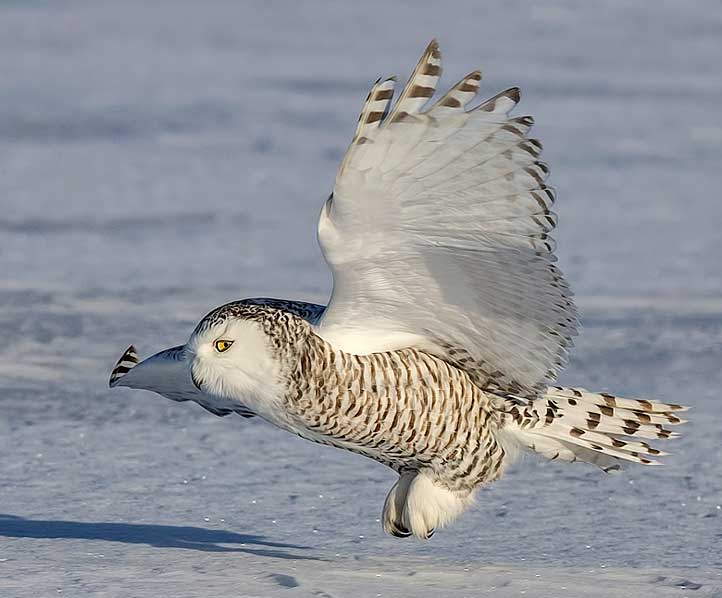The Snowy Owl is a large, white owl with small black markings, long, broad wings, and a broad tail.
These special birds are easy to see on their remote breeding territories but can require some effort on their wintering grounds. Some of the best places to look for them in winter are airports and big, open farm fields in southern Canada, Alaska, the Great Lakes region, and the northern border of the lower 48 states.
On this page
Identification
Male
The male Snowy Owl is a large, white owl with a rounded or slightly square-shaped head, and yellow eyes. This big raptor is slightly larger than a male Great Horned Owl.
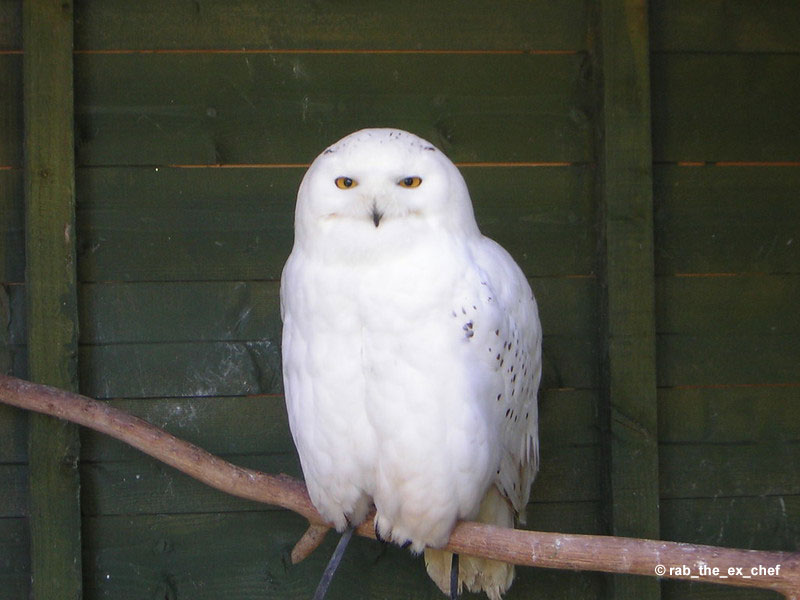
Male Snowy Owls generally have pure-white plumage. © rab_the_ex_chef
Males are completely white with some small black markings on their backs, wings, tail, and belly. As they get older, their plumage becomes whiter, and some males are entirely white. Their black beak also stands out on their white face and they have feathered legs with sharp black talons.
The average male Snowy Owl is 23 inches long, has a wingspan of 50 inches (4.1 feet), and weighs 3.9 pounds.
Female
The female Snowy Owl shares features with her male counterpart, such as yellow eyes and a black beak on a white face but differs in a couple other ways.
She is similar to the male in shape but is a little bit bigger. In terms of weight, the hefty female Snowy Owl is actually the biggest owl in North America!
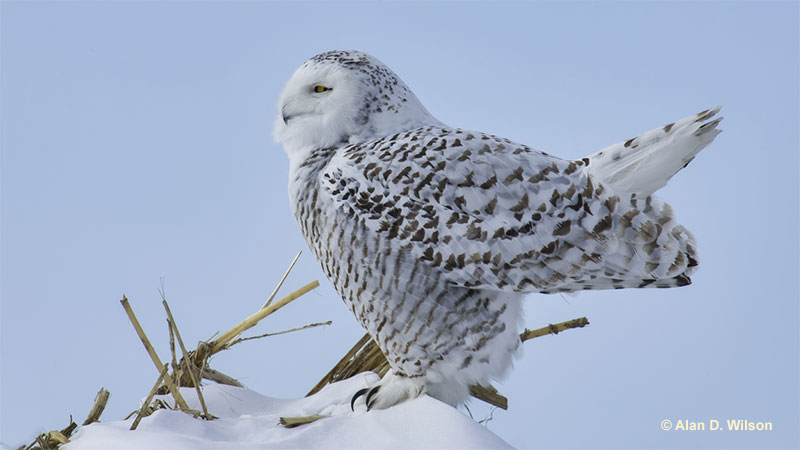
© Alan D. Wilson
The average female is 24.2 inches long (around two feet), has a 52-inch wingspan (more than four feet) and can weigh 5 pounds.
Related: Can you have an owl as a pet?
Female Snowy Owls also have much more black barring on their head, back, wings, and underparts.
Food
Snowy Owls are very adaptable birds that feed on a wide variety of prey. However, on their breeding grounds, lemmings and other small rodents make up a large part of their diet. They also catch ptarmigans and their chicks, shorebirds like phalaropes, and other birds, especially when small rodents are absent or scarce.
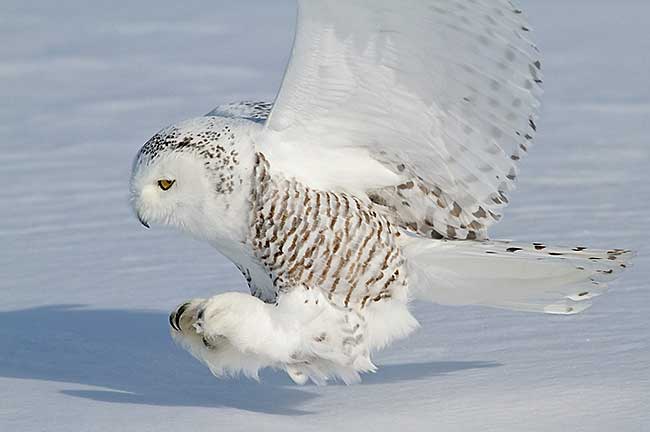
During migration, Snowy Owls can follow and prey on ducks and ptarmigans. They also prey on these and many other birds and mammals on their wintering grounds. They can even catch and kill birds as large as geese, other owls, hawks, falcons, and rabbits and other mammals.
Once in a while, Snowy Owls will eat carrion, but they prefer to feed on freshly killed animals.
This big owl often hunts by perching on a mound, telephone pole, or other elevated spot in open terrain and watching for animals. When it spots a rodent or other potential prey item, it quickly flies towards it and glides in to catch the animal with its talons.
They can also fly after and catch birds flight, or hover in place and dive down onto small animals. The Snowy Owl may prefer to hunt at dawn and dusk but can hunt at any time of the day or night.
Nesting and Eggs
The female Snowy Owl makes a nest by scraping out a shallow depression on the ground. She picks a ridge, mound, or other dry and elevated spot that won’t accumulate snow. Her nest can have some feathers and bits of moss, but those materials are probably in the nest by chance.
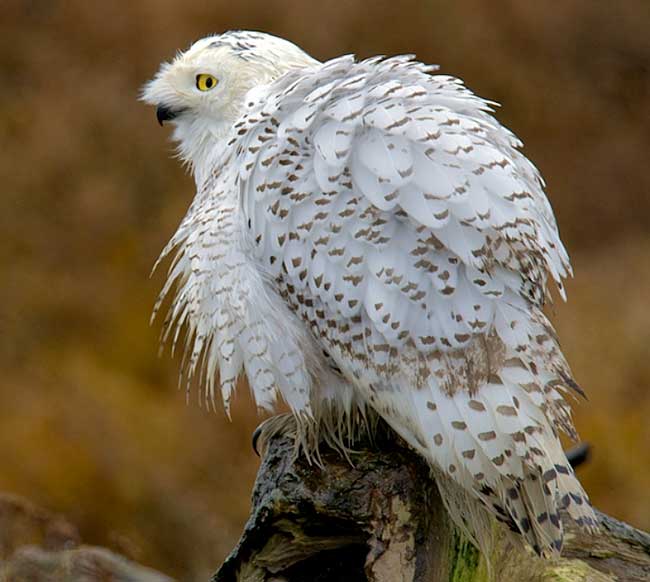
Females have also been seen making a second nest in a more sheltered spot below the first one. During storms or high winds, those female Snowy Owls moved their nestlings to this second nest.
The female Snowy Owl lays a big clutch of five to eight dull, creamy white eggs and incubates them for 32 days. The average Snowy Owl egg is 2.2 inches long, and weighs about 1.8 ounces.
During incubation, the male brings food to his mate. After the eggs hatch, he continues to bring food for the female owl and the nestlings, but the baby owls are only fed by their mother.
They usually eat prey whole, swallowing rodents and small birds headfirst.
After three weeks, the young birds wander out of the nest but are still dependent on their parents until they migrate. They can fly when they are eight weeks old.
Vocalizations
Male Snowy Owls are a bit more vocal than females, but both are known for their barking-like krooh krooh krooh calls.
Females tend to chirp a bit more and make higher screaming sounds. Both sexes can squeal, grunt, cackle, and hiss.
Current Situation
Snowy Owls breed over a huge area but have very low-density populations where small numbers of birds are scattered over thousands of miles of tundra.
They breed in the high Arctic tundra in the northern hemisphere and winter in coastal marshes, farm fields, airports, and other open habitats.
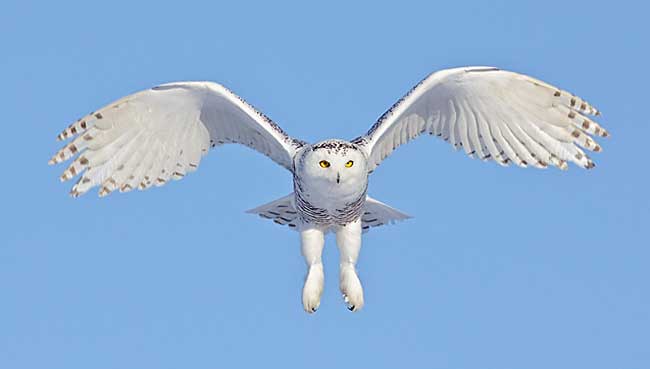
In North America, Snowy Owls are regular in winter in Alaska, much of Canada, and the northern part of the lower 48 states. In some winters, dozens or even hundreds of Snowy Owls can occur and also show up south of their usual range.
This species is listed as Vulnerable in the IUCN Red List.
In 2018, the Least Concern status for the Snowy Owl was changed to “Vulnerable” after studies showed large declines in its overall population. A warming climate has been affecting the Arctic ecosystems this bird depends on for survival. On its wintering grounds, it is also affected by eating poisoned rats, and collisions with vehicles.
Facts
- The Snowy Owl has incredible eyesight. Studies have shown that it can spot prey nearly a mile away!
- Snowy Owls take advantage of high prey abundance to raise more young. In some years, when lemmings are abundant, this owl lays 14 eggs!
- This species has extra feathers, especially on its feet. The extra feathers are adaptations to help protect it from extremely cold weather on its Arctic breeding grounds.
- On their wintering grounds, a Snowy Owl sitting on the ground in a field can be easily confused with a white plastic bag! If you are birding at an airport or open field in the winter, it’s worth checking any lone “plastic bag” on the ground. A closer look could reveal a resting Snowy Owl.
- No owl breeds further north than the Snowy Owl. In fact, few other birds breed as far north as this Arctic species. It even occurs in northern Greenland and northern Canada, above the Arctic Circle.
Similar Species
The Snowy Owl is one of the easiest birds to identify. Even so, a couple species could potentially be confused with this big white owl.
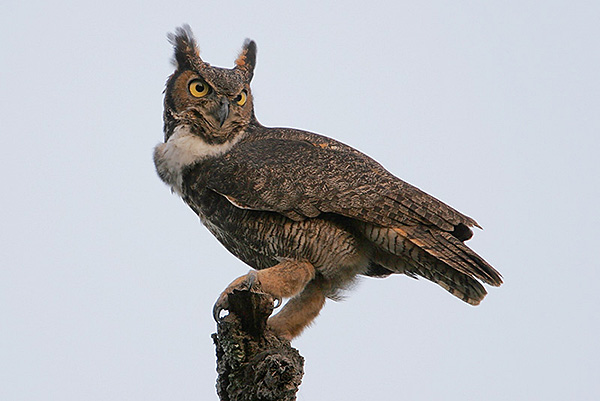
Great Horned Owl. © Greg Lavaty.
Most Great Horned Owls look nothing like the Snowy Owl.
However, some Great Horned Owls from northern Canada and Alaska have pale gray plumage with barred underparts.
These birds can look a bit like young Snowy Owls but can be recognized by their big ear tufts and gray face.
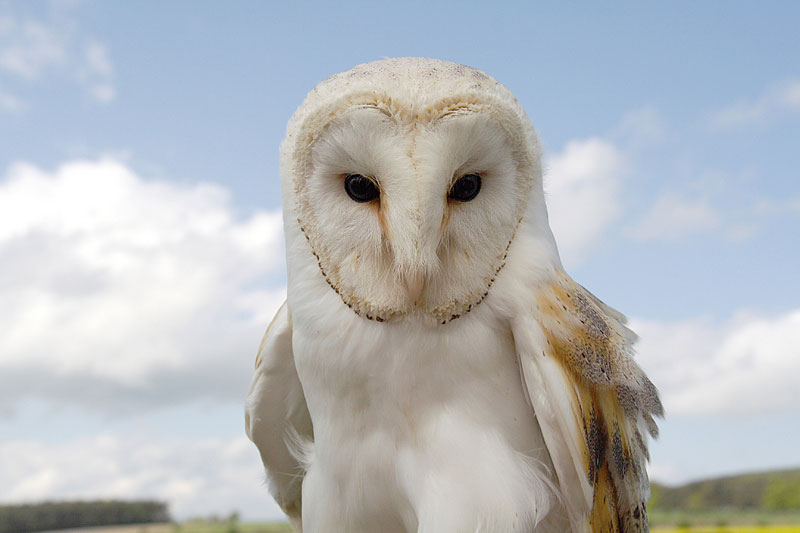
Barn Owl
A Barn Owl in flight could be mistaken for a Snowy Owl. It has a similar shape, is pale, and can show a lot of white when flying.
However, it also has some golden brown and gray in its plumage, a distinctive heart-shaped face, and dark eyes.
It also lacks the black barring shown by female and young Snowy Owls.
Frequently Asked Questions
How rare is it to see a Snowy Owl?
It is not rare to see a Snowy Owl in Alaska or northern Canada. They can also be regularly seen at airports and other open habitats in southern Canada and some parts of the northern USA. However, even in those places, there aren’t that many Snowy Owls and they can be tough to find. They are definitely rare south of their regular range.
Where do Snowy Owls live at?
Snowy Owls live in tundra and other open habitats in the Arctic. In winter, some also occur at airports, coastal marshes, in farm fields, and other open areas south to Wisconsin and New York.
Why are Snowy Owls special?
Snowy Owls are special because they are the only owl that is nearly or entirely white. They are also the only owl species that mostly nests north of the Arctic Circle.
How aggressive are Snowy Owls?
Snowy Owls are not aggressive on their wintering grounds. However, at their nests, they can dive bomb people, wolves, and other animals that venture too close.
How intelligent are Snowy Owls?
Snowy Owls are not as smart as crows or ravens but are fairly smart birds. They have to use their brain to figure out how to catch prey in a variety of situations.

